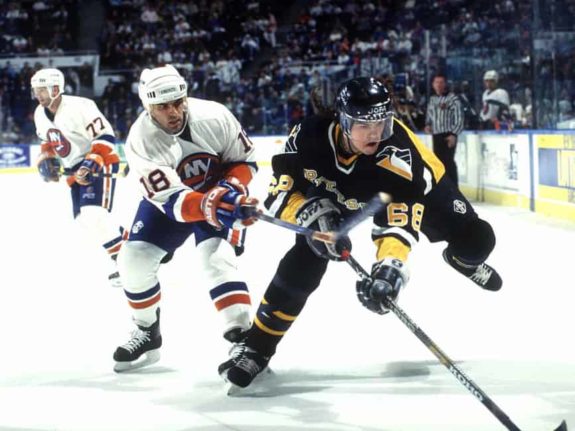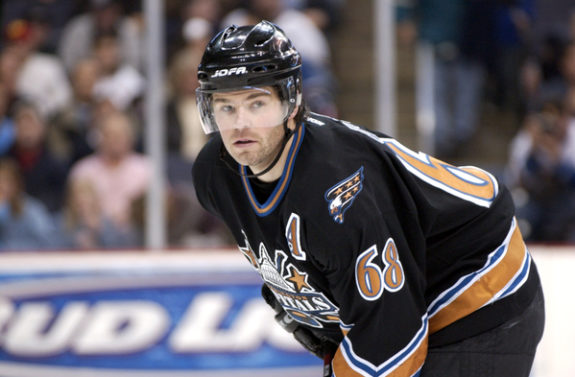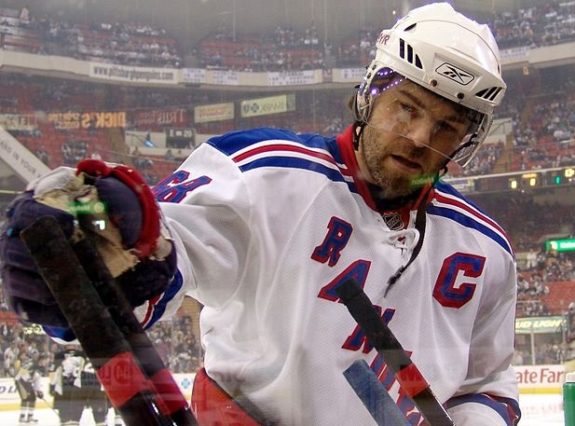Just hours after Washington Capitals star Alexander Ovechkin claimed his second consecutive ESPY award for Best NHL Player, a Capitals star of the past took to social media to take “credit”…of sorts…for the Caps’ recent run of success.
“After 18 years we should look the positive way. If I would play very good , you would never had a chance to draft OVI. And you would probably didn’t win the cup last year😀👍…….. you welcome😎”
While Jaromir Jagr was obviously joking, there is a grain of truth in those words. Fact is, the Capitals’ recent run of success wouldn’t have happened were it not for one of the costliest signings in recent NHL history, one which set the franchise back nearly a decade.
Setting up the Trade
Since taking over the position in 1997, then-general manager George McPhee (who, ironically, would later become the architect of the Vegas Golden Knights team that the Capitals vanquished 20 years later) wasted no time turning the Capitals into a Stanley Cup contender. In his first season, they advanced to the Cup Final, where they were swept by the Detroit Red Wings. However, subsequent seasons produced diminishing returns. This included the following season, 1998-99, when the Capitals missed the playoffs in a season plagued by injuries and bad luck.
Related: Jaromir Jagr – A Retrospective in Quotations
Over the offseason, then-AOL Time Warner executive Ted Leonsis purchased the team and began implementing a five-year plan to win the Stanley Cup. Progress on that front remained slow, however. While they recovered to win the Southeast Division in the 1999-00 and 2000-01 seasons, all they had to show for it were back-to-back first-round losses to their bitter rivals, the Pittsburgh Penguins, and their superstar tandem of Mario Lemieux and Jaromir Jagr.

Those same Penguins had problems of their own, however. Jagr had grown bitter with his situation in Pittsburgh, openly feuding with head coach Ivan Hlinka throughout the 2000-01 season. (from ‘Jagr Not Happy With Production,’ LA Times, 12/10/2000) With Lemieux coming out of retirement, Jagr suddenly found himself playing second fiddle even though he was the one wearing the captain’s ‘C.’ Worse, the cash-strapped Penguins could not afford to keep two superstars on their payroll, leaving them with no other recourse but to trade the four-time scoring champion.
Stanley Cup or Bust
In Leonsis and the Capitals, they found a willing trade partner, although McPhee was not as gung-ho about the idea.
“I wasn’t sure that it was the right player at the right time for us,” McPhee said to the Dump ‘n’ Chase blog in 2014. “We were building our organization with bricks and when we did that, we suddenly went to siding or a different material. We got on a different bus. It’s always about team construction and we weren’t really constructed the right way to absorb him.”
You may also like:
- 3 Keys to the Rangers Winning Games 3 & 4 in Washington
- Rangers Hold Off Capitals to Take Game 2
- Projected Lineups for the Capitals vs Rangers – Game 2
- Rangers Defeat Capitals 4-1 for 1-0 Series Lead
- Projected Lineups for the Capitals vs Rangers – Game 1
Nevertheless, on July 11, 2001, the Capitals stunned the hockey world by acquiring Jagr – and defenseman Frantisek Kucera – in exchange for three prospects: Kris Beech, Michal Sivek and Ross Lupaschuk, none of whom amounted to anything in the NHL.
“The good news is we didn’t give them anything,” McPhee added.
The Capitals tore up what was left of Jagr’s Penguins contract. Three months later, as the regular season approached, the Caps locked him up for what they were certain would be his long-term future – seven years and $77 million, plus an option for an extra year for another $11 million. At the time, it was the richest contract in NHL history. (from ‘Jagr, Capitals Agree to Deal for $88 Million,’ LA Times, 10/19/2001)
The Payoff
It seemed like Jagr couldn’t have found a better place to land. In Washington, he took charge of a line that also included fellow All-Stars Peter Bondra and Adam Oates. Hockey pundits took it as a given that the Capitals would, at the very least, repeat as division champions. It came as a surprise when they missed the postseason completely.

In November, the team suffered a six-game winless streak from which they never truly recovered. Despite a late charge near the end, the Capitals finished two points short of a playoff spot. Head coach Ron Wilson, who had led Washington to the Final in 1998, was fired after the season. While Jagr led the team in scoring, his play went from “spectacular” to merely “great” when the team needed him to be spectacular. His 31 goals that season, an enviable total for 99% of players, were his lowest since his rookie season in 1990-91.
The following season, under new coach Bruce Cassidy, the Capitals rebounded to finish sixth in the Eastern Conference. Jagr’s linemate from Pittsburgh, Robert Lang, signed with Washington and put up 69 points, helping take some of the load off. In the postseason, the Capitals took a 2-0 series lead over their division rivals, the Tampa Bay Lightning, and it looked for a moment as if Leonsis’ five-year plan for winning the Stanley Cup was back on track.
But then Game 3 happened.
As fate would have it, Jagr had a hand in the Caps’ dramatic downfall, though not directly. Linesman Bill McCreary called a controversial roughing penalty on Jagr, and an elbowing penalty on Ken Klee a minute later, gifting the Lightning a 5-on-3 power play. Seventeen seconds after Klee set foot in the sin bin, Vincent Lecavalier scored the game-winner for the Lightning, sending the Capitals on the road toward misery, tanking, and Ovechkin.
The Capitals never recovered from the sudden blow. They lost the next three, the final blow coming on Martin St. Louis’s triple-overtime goal in Game 6.
End Game
The 2003-04 season was a total loss from the first month. After an opening day win, the Capitals lost seven of eight games, the other a tie with the Toronto Maple Leafs. It became clear to all, including McPhee and Leonsis, that this Capitals team was not capable of making the playoff push that had been expected of them. By midseason, they started their fire sale, offloading their expensive signings – Jagr chief among them.

It was just as well, as Jagr was in the midst of his worst season yet. After 46 games, he’d netted only 16 goals. In Jan. 2004, his tenure in Washington ended with a trade to the New York Rangers. The team he left behind finished the season with 59 points. Leonsis’ fire sale paid off in the end, however, as the Capitals won the Ovechkin sweepstakes and earned the first overall pick in that year’s NHL Entry Draft, sparking off a path to the 2018 Stanley Cup.
For Caps fans, there is still the question: What if Jagr had played up to the standard that he had set in Pittsburgh? Would they have had to wait until 2018 for their first Cup? How would the Capitals look without Ovechkin?
